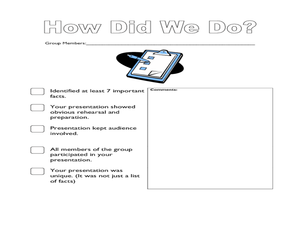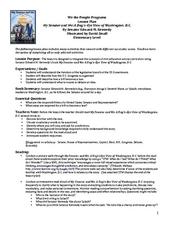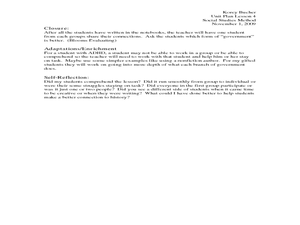K12 Reader
Branches of Government
Set down the basics of the three branches of government with the reading passage included here. After reading, class members answer five questions related to the passage.
Curated OER
Constitution Jeopardy
Although just a quick review of general information learned about the Constitution and U.S. government, this presentation could be used as a fun activity before the beginning of a class lesson, or as an independent experience. The...
Teaching Tolerance
Critiquing Hate Crimes Legislation
The high school instructional activity explores what hate crimes are and how the government has responded to those crimes. Academics read legislation, analyze political cartoons, and complete hands-on-activities to understand what...
Curated OER
Branches of US Government
Students research the responsibilities of the legislative, executive, and judicial branches. In this U.S. government instructional activity, students research the jobs of those in each branch and present their finding to their classmates.
Curated OER
The Branches of Government
After reviewing and reading about the three branches of US Government, complete this activity with your class. In groups, they will place their "cards" on the board under the correct branch. This lesson is weak and unclear. I'd make a...
Curated OER
Branches of Government Worksheet
This is a basic multiple choice activity. Learners answer a set of 9 multiple choice questions about early colonists and branches of government. You might use this as a check for understanding or a quick quiz. The first 2 questions are...
Curated OER
Legislative Branch (Congress) Questions
In this U. S. government worksheet, students respond to 10 short answer questions about the responsibilities of congressional members.
C-SPAN
The Role of the Executive Branch in Policy Making
Although the president of the United States does not have the power to pass laws, they can propose legislation, veto bills passed by Congress, and issue executive orders that bypass Congress. Six video clips show middle schoolers these...
University of North Carolina
Congress and the Legislative Process: A Simulation in How a Bill Becomes a Law
As part of the study of the legislative process, scholars research redistricting and gerrymandering and the effects of these activities on lawmaking. On day one of the two-day plans, individuals redistrict the state of Elbonia so that...
Curated OER
Lobbying
Students examine the role of lobbyists in Washington, D.C. In this Legislative Branch lesson, students watch video segments and read excerpts about lobbying. Students write essays that explore the pros and cons of lobbying.
Curated OER
My Senator and Me: A Dog's-Eye View of Washington, D.C.
Although this legislative process lesson is designed to accompany a specific text, it is valuable independently. Young learners participate in a picture walk (worksheet included) through My Senator and Me: A Dog's-Eye View of Washington,...
American Bar Association
What Is Separation of Powers?
Who has the power? Scholars investigate the creation of the three branches of government in the United States Constitution. They analyze just why the framers created the branches the way they did.
USA.gov
Three Branches of Government
Here is a very simple handout that illustrates how the Constitution provides for a separation of powers between the legislative, executive, and judicial branches.
Curated OER
Why Does Congress Work That Way?
Students discover the powers of Congress. In this legislative branch instructional activity, students examine the legislative process as they analyze Article I of the U.S. Constitution. Students consider the powers of Congress as they...
C-SPAN
Presidential Veto and Congressional Override
One of the key powers of the executive branch is the president's ability to pass or veto legislation proposed by Congress. Congress, the legislative branch, on the other hand, can override a president's veto. Five film clips show how the...
National Endowment for the Humanities
Lesson 4 James Madison: Internal Improvements Balancing Act—Federal/State and Executive/Legislative
Who has the power? The founding fathers asked the same question when the United States was formed. Learners explore issues that arose during Madison’s presidency that raised constitutional questions. Through discovery, discussion, and...
Curated OER
The Role of the Executive Branch in the Lawmaking Process
Learners examine Article I, Section 7, and Article II, Sections 2 and 3, of the U.S. Constitution, explain the president's role in the lawmaking process, and define the term veto.
Curated OER
Separation of Powers Between the Three Branches of
Students investigate the concept of the three branches of government by dividing into three teams. They record the powers of the three branches.
Curated OER
Constitutional Sort
For this U.S. Constitution worksheet, students complete a graphic organizer that requires them to list responsibilities of members of the legislative, executive, and judicial branches.
Curated OER
Legislators and Representation - Executive, Federal and Interest Group Relations
High schoolers explore the interaction between the legislature and other governmental institutions. They watch videos exploring the relationship between the state legislature and two government institutions, and the role of lobbyists on...
Curated OER
The Three Branches of Government (Legislative, Executive, Judicial)
Fifth graders compare the three branches of government to a three-legged chair. In this government lesson, 5th graders discuss the Founding Fathers, the Constitution, and checks and balances. Students study what each branch of government...
Curated OER
Types of Branches
Fourth graders study the three branches of government. In this politics lesson, 4th graders list the three branches of government, understanding what each branch does, and compare and contrast how government is run with how the school is...
Curated OER
Three Branches of Government
Fourth graders listen to a lecture about the government of Indiana, and the three branches of government. They discuss the reasons for the three branches and read from their text the information on government. Students play a game to...
Curated OER
The Role of the Judiciary in a System of Separation of Powers and Checks and Balances
Students determine the role of each branch of government in a system of checks and balances. They demonstrate the role of the judiciary in American government

























